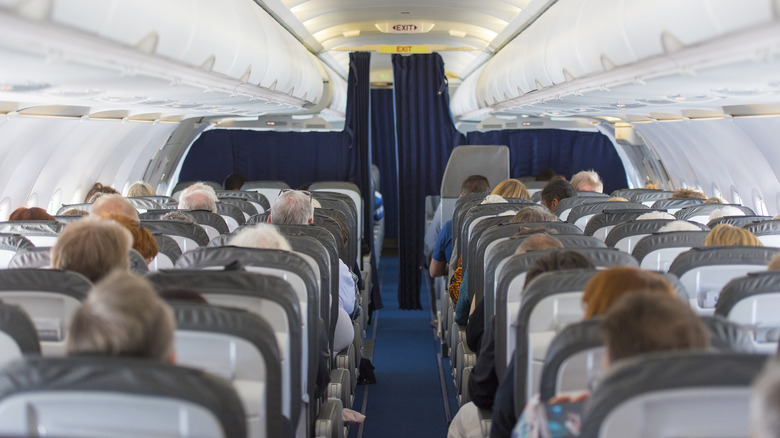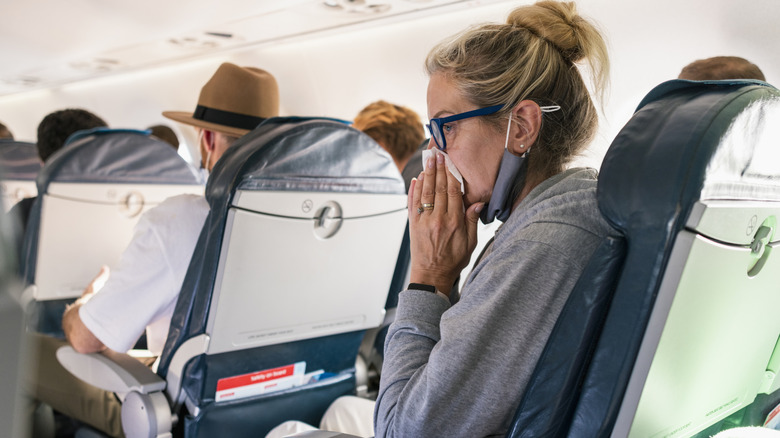Scientists Call This Gross Occurrence In An Airplane Cabin 'The Pig-Pen Effect'
Dry throat, itchy eyes, a slight headache, or a groggy feeling — you've probably felt those things at some point while sitting in your airplane seat. You might assume it's jet lag or air sickness, but think twice: It could be something else, such as a phenomenon scientists call " the Pig-Pen effect," named after the "Peanuts" character who's always surrounded by a cloud of dust and dirt. What is this effect about? It occurs when ozone reacts with the natural oils or other substances on your skin or clothing, forming irritants that affect the eyes, nose, throat, chest, and lungs.
Although ozone serves a protective purpose in the upper atmosphere, it becomes a problem when it gets into the cabin. The ozone gases often enter through the plane's ventilation system, especially in the lower stratosphere where ozone levels are higher. Each passenger brings in and leaves behind an invisible chemical haze or cloud of pollutants — like Pig-Pen himself. In this case, the "dirt" or pollutant is the natural oil the body produces, which combines with ozone and compromises the freshness of the air.
Why the Pig-Pen effect is such a big deal
You might wonder why this matters, and whether it could cause trouble during your flight. Actually, ozone levels inside some planes can rise to the point where passengers become noticeably uncomfortable. With fatigue and symptoms like shortness of breath setting in, it can be hard to tell what's really to blame. If the aircraft lacks functional ozone converters, irritation becomes more likely within a few hours, since the converters are designed to turn harmful ozone (O3) into breathable oxygen (O2).
When ozone and human body oils collide, they create byproducts such as formaldehyde, carbonyls, and acetone — compounds that cause the irritations and allergic reactions passengers often experience. A 2007 study, in which volunteers were placed in simulated cabin conditions with varying ozone levels, confirmed this. Worse still, the chemical reaction doesn't leave the cabin even before takeoff or long after landing, since residual oils remain on seat fabrics, tray tables, and armrests. And while the pollution cloud may not be visible, you'll certainly still feel its effects, especially in crowded cabins or on longer flights — even those with good ventilation.
How to minimize the effect and protect yourself on your next flight
You may not be able to escape the Pig-Pen effect entirely, but you can reduce its impact through several steps. Start by wearing freshly laundered clothes made of breathable fabrics. Clean clothes carry fewer oils, which means fewer chemical reactions with ozone. Wearing long sleeves and pants can also help, especially during long-haul flights, since covering up limits the exposure of your skin oils. To combat dryness while traveling, bring along saline eye drops and moisturizer. A fragrance-free face wipe or hydrating mist can also help soothe irritation mid-flight.
If you have respiratory conditions that make you sensitive to air quality, it's best to choose modern wide-body planes when possible, as they typically have catalytic ozone converters. Avoid long-distance and high-altitude flights when you can, as they pose a greater risk of ozone exposure. When determining how to choose the best airline seat, remember to select a location away from high-traffic areas like restrooms and galleys to minimize exposure. Most importantly, if your symptoms worsen after boarding, stay hydrated — always a key travel tip, even in winter. Drink plenty of water, but skip alcohol and caffeine; they'll only make the discomfort worse.


